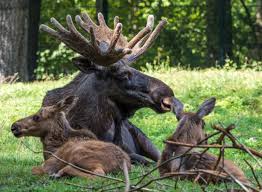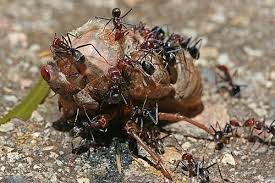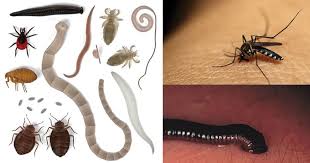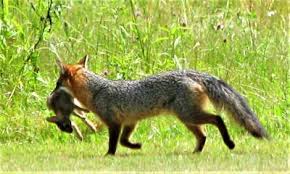There is also an interaction between prey with periodic cycles and predators. As the population expands, there is more food available for predators. As it contracts, there is less food available for predators, putting pressure on their population numbers.
Read Also: Amazon Flowers: All You Need To Know About
Population cycles in a Swedish forest community

The top figure (a) shows changes in population size for voles and small game. The striped arrows indicate years in which voles consumed tree bark as a marginal food. The bottom figure (b) illustrates how predator populations change in relation to prey abundance.
1. Examples of Population Changes in Predator-Prey Systems
Some of the most notable examples of population changes occur in species that experience large, cyclic swings in population size. Quite often, these cycles co-occur with population cycles of other species in the same location.
For example, red foxes (Vulpes vulpes) in northern Sweden prey on voles, grouse, and hares. Studies of these species have demonstrated linked population cycles in each of the prey species, with population peaks every 3–4 years (Figure 1). What drives these cycles?
2. Influence of Food Availability on Herbivore Population Size
Grouse, hares, and voles feed on vegetation, and the availability of their preferred foods will influence the population size of each. The availability of food acts as a bottom-up control that affects population size. In years when their preferred food items are abundant, populations will grow.
When preferred foods are scarce, individuals must turn to less desirable foods to prevent starvation. They grow more slowly, reproduce less, and populations decline. When vole populations peak and competition for food is strongest, they turn to bark as a marginal food, and this shift in foraging behavior coincides with a population decline.
Grouse and hare populations cycle in a manner comparable to those of voles, which suggests that food availability plays a role in regulating populations of these herbivores.
Predator Behavior and Response to Prey Abundance

Foxes prefer to consume voles and other small rodents, but will occasionally eat grouse and hares when voles are less abundant. It is expected that the number of foxes in the population would increase as availability of their preferred food increases, and studies have demonstrated that this does, in fact, occur (Figure 1b). Owl populations cycle in a similar manner, closely following the abundance of voles.
Predation Pressure and Its Role in Population Control
As predator populations increase, they put greater strain on the prey populations and act as a top-down control, pushing them toward a state of decline. Thus both availability of resources and predation pressure affect the size of prey populations.
It is difficult to determine the extent to which each of these controls drives population cycles in the Swedish boreal forest, because this system is not amenable to caging experiments, but studies show that food and predation work together to regulate population sizes.
Experimental Studies of Snowshoe Hare Populations and Population Dynamics
Average snowshoe hare density increased under conditions of supplemental food and predator-removal. Density increased dramatically when both food and predation were modified.
1. Experimental Design and Implementation
Field experiments by Charles J. Krebs and colleagues have experimentally teased apart the influence of food abundance and predation on snowshoe hare (Lepus americanus) populations in Canada. They established nine 1 km² blocks in undisturbed forest.
Three plots served as controls. The researchers used the remaining six to test the effects of resource availability, predation, and the interaction of both factors on snowshoe hare populations. They stocked two blocks with supplemental food for the duration of the experiment to test the effect of resource availability.
To test the effect of predation pressure, they enclosed two blocks with electric fences to exclude mammalian predators (hawks and owls retained access).
They treated the remaining two blocks with fertilizer to increase plant abundance. Of the two predator-exclusion blocks, one contained supplemental food to examine the influence of both resource availability and predation pressure.
The food supplements provided higher-quality nutrients than did plants growing in the forest. On each of these plots, they captured, marked, and released the hares twice each year: in March, before the onset of the breeding season, and in October, at the onset of winter.
2. Findings on Food and Predation Effects
Krebs and colleagues followed snowshoe hare populations on the nine plots over a course of eight years, through one population cycle in which the population peaked and declined on each study plot. At the end, they averaged the number of hares over the experiment.
They found that blocks with supplemental food increased hare density three-fold, whereas fertilizer increased plant biomass on treated plots but did not correspond to an increase in hares.
These findings suggest that resource quality, rather than resource availability, acts as a bottom-up control on hare populations. The predator exclusion blocks increased the average density of hares two-fold, which supported the idea that hare populations were also controlled from the top-down through predation.
The most striking finding of the study came from the plot that both excluded predators and had supplemental food supplies. This block experienced an 11-fold increase in average hare density relative to the controls (Figure 2). The researchers found that the increased density of hares was due to both higher survival and reproduction on the study plots.
Understanding Predator-Prey Interactions Using Mathematical Models
Predator and prey populations cycle through time, as predators decrease numbers of prey. Lack of food resources in turn decreases predator abundance, and the lack of predation pressure allows prey populations to rebound.
1. Lotka-Volterra Model in Population Ecology
To survive and reproduce, individuals must obtain sufficient food resources while simultaneously avoiding becoming food for a predator. The snowshoe hare study demonstrates the role of both predator avoidance and food availability on population sizes.
The trade-off between food intake and predator avoidance is not easily addressed in the field, and ecologists have turned to mathematical models to better understand foraging behavior and predator-prey dynamics, just as economists and atmospheric scientists do.
2. Application of Mathematical Models
Lotka-Volterra models provide a useful tool to help population ecologists understand the factors that influence population dynamics. They have been particularly useful in understanding and predicting predator-prey population cycles.
Although the models greatly simplify actual conditions, they demonstrate that under certain circumstances, predator and prey populations can oscillate over time (Figure 3) in a manner similar to that observed in the populations described above.
Foraging Behavior and Its Role in Predator-Prey Dynamics
1. Food Preference and Nutritional Trade-Offs
Few systems oscillate in the cyclical manner of those described thus far. In reality, predator-prey systems are complex; they often involve multiple predators and multiple types of prey.
What factors influence the type of prey an individual predator takes? What influences the foraging behavior of prey species? Under ideal circumstances, an individual will encounter high-quality food items on a regular basis.
These preferred foods provide the most nutritional benefit with the fewest costs. Costs for an organism may be handling time (e.g., time required to catch prey or remove a nut from its shell) or presence of chemicals, such as tannins, that reduce the nutritional quality of the food item.
2. Switching to Alternative Food Sources
When preferred foods are scarce, organisms must switch to other, less-desirable alternatives. The point at which an organism should make this shift is not easy to predict.
It depends upon many factors, including the relative abundance of each of the foods, the potential costs associated with each food, and other factors, such as the risk of exposure to predators while eating.
3. Case Study: Vole-Fox System
Consider the vole-fox system described in the first section. Field voles (Microtus agrestis) and bank voles (Clethrionomys glareolus) preferentially consume forbs and grasses, but they will turn to the bark from trees when their preferred foods become scarce.
Bark contains poorer-quality nutrients than do grasses and forbs. In addition, voles must venture into the open to approach trees to feed on bark, making them more vulnerable to predation by foxes, which rely on sight to find their prey. Only when the preferred foods are very difficult to find as occurs during times of population peaks do voles switch to bark.
Read Also: Pumpkin Flowers (Pumpkin Blossoms): Complete Growing and Care Guide
Parasite-Host Interactions in Population Dynamics

1. Role of Parasites in Regulating Host Populations
Thus far, the focus has been on herbivore-plant interactions and predator-prey interactions, but parasites also play an important role in regulating populations of their hosts.
The Francisella tularensis bacteria that cause tularemia are commonly found in both voles and hares in the Swedish boreal forest. Voles serve as a host species for F. tularensis and do not display symptoms of disease; however, other species, such as mountain hares (Lepus timidus), do exhibit symptoms of tularemia when infected.
Infection by these bacteria may play a role in the population cycles of these species (Figure 1b), though current data do not demonstrate a causal link.
2. Impact of Sarcoptic Mange on Predator Populations
Other parasites, however, have been shown to impact the overall food web. The ectoparasite Sarcoptes scabiei is a mite that causes sarcoptic mange. In the late 1970s and early 1980s, mange infected red foxes in Sweden, decreasing the numbers of foxes in the community by approximately 70%.
Erik R. Lindstrom and colleagues were surprised to discover that a decline in the fox population did not affect numbers of voles, which continued to oscillate as before.
The fox population decline did, however, result in increased population sizes of mountain hares and grouse. S. scabiei reduced the strength of top-down control exerted by foxes on these prey species, which increased numbers of individuals in the prey populations and damped the 3–4 year oscillation in population size for each.
3. Parasite Manipulation and Food Web Complexity
Parasites with complex life cycles require two hosts; in some of these systems, prey function as intermediate hosts for the parasite, with predators acting as primary hosts. Parasites can manipulate the behavior of the intermediate host to make transmission to the primary host more likely.
These changes typically occur when the parasite is at a stage of its life cycle when it can successfully infect the primary host. Behavioral changes that favor parasite transmission often involve unusual foraging behavior on the part of the intermediate host: foraging in locations that make the individual more susceptible to predation by the primary host.
As a result, parasites can change the size of prey populations during times of heavy infestation; as the parasites infect the primary host, predator populations may also decline.
4. Ecological Complexity and Human Impact on Population Dynamics
Species interactions occur on many levels, as part of a complex, dynamic system in ecological communities. Predators, prey, plants, and parasites all influence changes in population sizes over time.
Simple systems may undergo large, cyclical changes, but communities with more complex food webs are likely to experience more subtle shifts in response to changes in parasite load, predation pressure, and herbivory.
Consider, however, that humans have impacted many ecological communities by removing predators or reducing the availability of resources. How will such changes affect population fluctuations in the rest of the community?
Evolutionary Dynamics in Predator-Prey Systems and Their Agricultural Relevance
1. Ecological Context of Coevolution
Evolution takes place in an evolutionary setting that typically involves interactions with other organisms. To describe such evolution, a structure is needed which incorporates the simultaneous evolution of interacting species.
A formal framework for this purpose is suggested, extending from the microscopic interactions between individuals the immediate cause of natural selection through the mesoscopic population dynamics responsible for driving the replacement of one mutant phenotype by another, to the macroscopic process of phenotypic evolution arising from many such substitutions.
2. Understanding Coevolution in Agricultural Ecology
The process of coevolution that results from this is illustrated in the predator-prey systems. With no more than qualitative information about the evolutionary dynamics, some basic properties of predator-prey coevolution become evident.
More detailed understanding requires specification of an evolutionary dynamic; two models for this purpose are outlined, one from research on a stochastic process of mutation and selection and the other from quantitative genetics.
Much of the interest in coevolution has been to characterize the properties of fixed points at which there is no further phenotypic evolution.
Stability analysis of the fixed points of evolutionary dynamical systems is reviewed and leads to conclusions about the asymptotic states of evolution rather than those of game-theoretic methods. These differences become especially important when evolution involves more than one species.
Do you have any questions, suggestions, or contributions? If so, please feel free to use the comment box below to share your thoughts. We also encourage you to kindly share this information with others who might benefit from it. Since we can’t reach everyone at once, we truly appreciate your help in spreading the word. Thank you so much for your support and for sharing!

